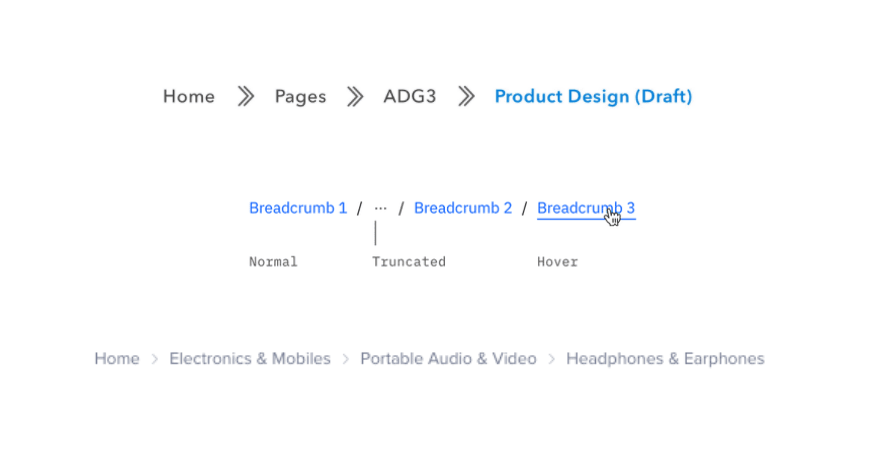Why they exist
User experience is just as important as the content of your website. A user should be able to easily and intuitively navigate through your website. This is why “breadcrumbs” exists.
What it means
In simple terms, a breadcrumb is a footprint that helps a visitor navigate a website in an organized way.
In technical terms, a breadcrumb is a navigational element used to indicate the current page the user is relative to the page's hierarchy.
Scenario
Let's say we need to design a breadcrumb for when the user is searching for the award-winning fiction books.
Books › Science Fiction › Award Winners
UI exploration
HTML blueprint
Let's start with the semantic HTML Structure of a breadcrumb and I'll break down each part:
<nav aria-label="breadcrumb">
<ol>
<li>
<a href="http://site.com/books">Books</a>
</li>
<li>
<a href="http://site.com/books/sciencefiction">Science Fiction</a>
</li>
<li>
<a
href="http://site.com/books/sciencefiction/award-winners"
aria-current="page"
>
Award Winners
</a>
</li>
</ol>
</nav>
- The
<nav>tag shows that the breadcrumb is a navigation element. Addingaria-labelgives it a label that screen readers can announce.
A screen reader is a technology that speaks out text on a screen based on where the user is currently focused.
The
<ol>tag shows that the breadcrumb is an ordered list of links.The
<li>tag represents a breadcrumb item that houses the link.
Typically when you use
<ol>or<ui>in HTML, it needs to have a<li>.
- The
<a>tag represents a breadcrumb link. Notice the last link hasaria-current="page". This is used to indicate that it represents the current page.
Styling the breadcrumb
When styling widgets like this, I tend to limit the use of class names and prefer to leverage the structure of the HTML in CSS.
Recap: Here's the HTML structure
<nav aria-label="breadcrumb">
<ol>
<li>
<a href="http://site.com/books">Books</a>
</li>
<li>
<a href="http://site.com/books/sciencefiction">Science Fiction</a>
</li>
<li>
<a
href="http://site.com/books/sciencefiction/award-winners"
aria-current="page"
>
Award Winners
</a>
</li>
</ol>
</nav>
Then here's how I'd style it using SASS or SCSS.
nav[aria-label="breadcrumb"] {
padding: 10px;
ol {
list-style-type: none;
display: flex;
li {
// little trick to add "/" separators
&:not(:last-child):after{
content: "/";
color: #c4c4c4;
display: inline-block;
margin: 0 12px;
}
a{
color: rgb(102, 112, 255);
text-decoration: none;
&:hover{
text-decoration: underline
}
// style the breadcrumb that represents the current page
&[aria-current="page"]{
color: #333;
text-decoration: none
}
}
}
}
}
Here's the codesandbox for the HTML and CSS. Feel free to play with it.
Creating a component
Since I mostly use React.js so here's I'd transform the HTML markup to composable components. I believe something similar could be done with Vue, Svelte, etc.
// encapsulate the `nav` and `ol`
function Breadcrumb(props) {
const { children, ...rest } = props;
return (
<nav aria-label="breadcrumb" {...rest}>
<ol>{children}</ol>
</nav>
);
}
// make this the `li`
function BreadcrumbItem(props) {
return <li {...props} />;
}
// make this the `a`
function BreadcrumbLink(props) {
const { isCurrent, ...rest } = props;
return <a aria-current={isCurrent ? "page" : undefined} {...rest} />;
}
// then we create the breadcrumb like this
function Example() {
return (
<Breadcrumb>
<BreadcrumbItem>
<BreadcrumbLink>Books</BreadcrumbLink>
</BreadcrumbItem>
<BreadcrumbItem>
<BreadcrumbLink isCurrent>Science Fiction</BreadcrumbLink>
</BreadcrumbItem>
</Breadcrumb>
);
}
I found that breaking a widget into smaller sub-parts makes it a lot easier to extend, compose, and style them. For instance, you could pass a
styleprop to any of the parts and style it anyhow you want.
That's it!
You've learned how to create a breadcrumb. Thanks for taking the time to read through this. I really hope you find it useful.
Comment below to let me know your thoughts
Feel free to check out the React component library I created called Chakra UI. Here's the link to the breadcrumb component specifically: http://chakra-ui.com/breadcrumb.
Stay safe!








Latest comments (0)